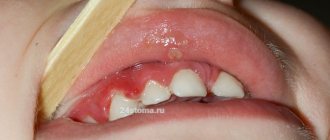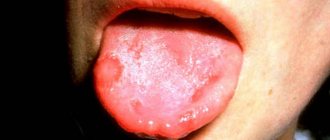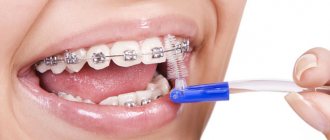A baby at the age of four months is not yet able to communicate what is bothering him, where it hurts, what factors cause discomfort. Typically, the first baby teeth begin to emerge at six months, but it is not uncommon for the middle incisors to appear in four-month-old babies. It is very important to recognize the signs of teething in order to help your baby get through this period as easily as possible.
Signs of teething in a 4 month old baby
On a note! Early teething is not considered a pathology. The age of 4-7 months is considered the norm for the appearance of the first primary incisors.
Teething Chart
The order of eruption of baby teeth
Everyone is different, but it is still important to know how most babies develop. Children's first teeth usually erupt almost simultaneously on the right and left. The sequence is as follows: first the anterior ones (incisors, canines), then the posterior ones.
It is important to understand that this pattern of teething in children is average, and in your case it may happen in a different order or at a different time. This does not necessarily indicate any violations.
Doctors have compiled an approximate, average diagram of teething in children:
Don't worry if you don't meet these standards for several months. If the parents got teeth late, most likely the children will have the same. Heredity has a very strong influence on development. The teething pattern should not become an unnecessary source of parental anxiety. This is just a guideline, like all other norms.
Both the sequence and timing of teething in children can vary greatly. Only if you are “late” by more than 6 months (for example, nothing appears until a year), it is worth discussing this with your doctor. There are genetic disorders when the rudiments of teeth do not develop at all. However, this is extremely rare. Some diseases also affect the timing of teething, but these conditions in children always manifest themselves with some more obvious symptoms.
In any case, there is no remedy that would “cut teeth” - we won’t pull them out of the jaw. We also do not regulate the cutting order. All that remains is to observe the process in children and take care of their health in general.
Baby teeth before birth
Children's teeth are formed even before they are born. In the womb, the strength of teeth, their health and appearance are determined. This happens at the beginning of the second trimester of pregnancy. And here it is very important that the expectant mother takes care of herself and monitors her health. The more carefully she follows the regime, the stronger the child’s teeth will be.
The formation of healthy teeth is impossible without calcium . There should be plenty of it in the mother’s body. This can only be achieved with proper and healthy nutrition. A pregnant woman's diet should include foods such as milk, fish, and seafood. You can also ask your gynecologist to prescribe special medications with a high calcium content.
It is worth paying attention to the fact that even with a lack of calcium in the mother’s body, the growing child will still take the necessary microelements, but at the same time will deplete the mother’s body. There will be a deficiency of calcium and potassium in the mother's bones and teeth, which will ultimately have a negative impact on the health of the fetus.
In the vast majority of cases, babies are born without teeth . In very rare cases, doctors discover central incisors in newborns in the delivery room. This phenomenon is considered an anomaly associated with excess calcium in the mother’s body or genetic characteristics.
What problems may arise during teething in infants?
Difficulties do not always arise. But sometimes, about 3 days before and 3 days after teething, the baby’s condition changes:
- gums swell;
- saliva flows more strongly (although a lot of it can be released without connection with teething);
- the temperature rises slightly;
- mood deteriorates (child is less active, cries more often);
- sleep becomes restless;
- stools become slightly looser and more frequent;
- your cheeks turn slightly red (no need to immediately look for allergens and change your diet).
These symptoms may not all appear, in any combination.
The difficulty is that the same symptoms, but usually stronger, can also occur in children with infections. Therefore, if your condition has changed significantly, consult your doctor.
Red flags (tell your doctor if your child has):
- temperature above 38 degrees in the absence of cold symptoms;
- a rash that is unfamiliar to you, which appeared along with a high fever;
- diarrhea, vomiting;
- lethargy;
- mouth ulcers or other sores.
- Eruption cyst (hematoma).
Assess how much the child's condition has changed. If he begins to clearly feel unwell, there is no need to attribute this to the teething of baby teeth. In this case, you need a doctor to rule out more serious problems.
How many days does it last
In answering this question, it should again be recalled that all children are different and react differently to the appearance of teeth. On average, fever in babies can last 1-3 days and usually disappears immediately after teething.
But in the experience of many pediatricians, there are children whose high body temperature associated with the appearance of their first teeth lasted up to 4-5 days. Or there are cases when the fever lasts only a few hours and goes away without any intervention. In any case, you should not delay consulting a doctor, since if you have any diseases, identifying them earlier has a more favorable outcome.
Medicines for teething in children
When your baby is in pain, you would like to have a reliable, effective medicine that you can give and sleep peacefully. As in the case of colic, when teething, the pharmacy will offer you a variety of remedies. Pediatric experts do not advise giving any medications without a doctor's permission.
Why? Homeopathic medicines are divided into true homeopathic (containing no active substance at all, and therefore ineffective) or pseudo-homeopathic. The latter contain some amount of plant components (usually chamomile and other, more exotic plants). The first ones do not work under any conditions, including teething in children, but at least they are harmless. Homeopathic remedies for pain containing belladonna (which was not even always listed in the composition) caused many deaths and were therefore strictly prohibited in developed countries.
In our country, the Commission of the Russian Academy of Sciences recognized homeopathy as a pseudoscience, but, unfortunately, there is no strict ban on potentially dangerous drugs. Since manufacturers do not always indicate belladonna in the composition, we recommend that you generally refrain from using any homeopathic remedies for teething pain in children.
Another case is gels with a local anesthetic drug (their name ends in “-caine”: usually benzocaine or lidocaine). Medicines like these are “freezes” that are injected into the gums when treating teeth. Although these drugs are obviously effective, they have also caused many child deaths. Substances of this group affect the functioning of the heart, because the gel is quickly washed off with saliva, and the child swallows it. It is especially dangerous if the parent uses a higher dose than recommended in the instructions. This happens often because these drugs only relieve pain for a few minutes. When the baby starts crying again, the parents apply more, often exceeding the dose. Now professional communities of doctors do not recommend the use of products with local anesthetics, but this does not stop their widespread advertising.
Other symptoms accompanying fever
During teething, there may be other symptoms in addition to fever. Swelling of the gums can spread from the oral cavity to the nasal mucosa, thereby causing a slight runny nose and the discharge of a slight transparent mucous secretion. This symptom is more pronounced when the upper teeth erupt.
The appearance of baby teeth is often accompanied by excessive salivation, especially when the lower teeth erupt. This also causes a slight loosening of the stool - the stool becomes a little softer than usual.
What to do when children are teething?
The most natural and one of the most reliable ways to reduce pain is cold. Pick up an item - a “rodent” that can be put in the refrigerator. Freezing them is not recommended because it can damage the baby's delicate gums.
Often children prefer to gnaw on their parent's finger or, unfortunately, on their mother's breast. But parents may not have enough patience for a long time, so it is better to find a suitable teether.
It should be:
- whole and durable (the child should not bite off pieces that could cause choking);
- without ropes and beads (the rope can pinch the neck or break, creating a risk of choking on a bead);
- without paint with toxic components;
- just clean (no need to disinfect it).
You can refrigerate the fruit puree or put a few wet cloth toys in the refrigerator so you can replace them.
Of course, children chew not only objects that are ideal for this. But if with a teether made of one piece of silicone or a mitten with a silicone pad the child can be left alone in the playpen for some time, then with a bunch of small objects on a string around the neck or a bracelet made of beads, the same as with some fruit or vegetable, you need to look after it.
If cooling does not help, and the stress of teething is very severe, discuss taking pain relievers and fever reducers (ibuprofen is most often used) with your pediatrician. To be on the safe side, consult your doctor, but a single dose by weight (for ibuprofen is 10 mg/kg), given once at night for 3-4 days of active teething, will not cause harm.
What should parents be wary of?
A child's body, weakened by teething, is very susceptible to bacterial or viral infection. Therefore, the baby’s symptoms may indicate complications:
- Severe nasal congestion , accompanied by copious discharge of purulent secretion. This suggests that on top of the usual swelling of the mucous membrane there is rhinitis, which must be treated.
- Loose stools . Fever and diarrhea together rarely accompany the appearance of teeth. This symptom may indicate the presence of some kind of intestinal infection, which the child could have introduced into the body with toys or gum teethers.
- Cough . With excessive salivation, children do not always have time to swallow saliva in time and sometimes choke on it, which causes periodic coughing. If the cough is systematic, accompanied by difficulty breathing or sputum discharge, then this speaks in favor of inflammation of the respiratory tract.
- Red throat . The inflammatory reaction that occurs in the gums during teething cannot spread to the mucous membranes of the throat. Redness of the palatine arches or pharynx is a sign of pharyngitis or acute respiratory infections.
- Vomiting often accompanies high body temperature in young children. But it may be a sign of damage to the nervous system or intestinal infection.
The presence of such signs requires urgent medical attention and appropriate treatment, regardless of what temperature (high or low) accompanies them.
Should I brush my newly erupted teeth?
Dentists strongly recommend starting to take care of oral hygiene from infancy. For newly emerging teeth, they offer special silicone brushes or wipes. A simpler option is a finger wrapped in gauze. You can simply moisten it with water or use toothpastes for children under 3 years of age (they are marked 0+ and can always be swallowed). The main thing when brushing your teeth is no violence! A little more cleanliness isn't worth the stress.
| Author Fedor Katasonov | Scientific editor Maria Gantman |
Growing pains
At 9-12 years of age, the growth of eye teeth can cause temporary inconvenience and discomfort. And at the age of one and a half years, as the first baby fang moves apart the gum in its desire to grow outward into the oral cavity, this can cause serious suffering to the child. Crying at night, whims - this is a short list of what the parents of a baby have to endure, with whom some kind of meaningful dialogue has just begun to develop, who seems to have already learned to react “correctly”, from an adult point of view, to the environment - and here The relationship between an owl slides down to the level of a baby.
Moreover, disoriented by the confusion of day and night into which their child has been driven, parents may mistake the symptoms of eye teeth growing into something else. In eye disease, as often happens. Therefore, contacting a pediatrician should take place as early as possible.
In complicated cases, the child will be prescribed medications that significantly reduce swelling of the gums and relieve pain. These, after a medical examination and prescriptions, can be pain-relieving gels “Metrogil Denta”, “Kalgel”, “Kamistad”.
In adolescence, it is time to replace a baby tooth with a permanent one. It often happens that a well-fitting baby tooth does not want to leave its place and prevents the “adult” tooth from taking its place between the incisors and premolars. In such a situation, the canine may grow incorrectly, with a displacement inward, towards the tongue, or outward, towards the cheek, which will distort the bite and will not contribute to normal chewing of food.
Temperature during teething
It is not uncommon for this symptom to bother a child during teething. If the temperature during this period does not rise above 38°, then most likely it is not associated with viral infections.
Medicines in suppositories can alleviate the condition.
It is this form of medication that will be safer at this age and will reduce the risk of allergies, unlike syrups containing dyes and sugar. But if the temperature lasts longer than two days, you should call a doctor.
Help the baby
The time when the first tooth comes out cannot be called easy. Rather, it is a test for the whole family. Sleepless nights, crying and whims are part of life. There is one consolation: the teeth will come out sooner or later, the torment will end. You need to be patient and learn to identify signs of teeth in a baby in order to help and alleviate the condition in a timely manner. This can be done with medications and mechanical methods.
Medicines
To reduce pain in inflamed gums, it is possible to use gels with a pronounced analgesic and anti-inflammatory effect. Using clean fingers, rub the gel into the gums. The most famous brands are “Kalgel”, “Kamistad”, recommendations should be obtained from a pediatrician.
In case of fever, it is necessary to give an antipyretic drug based on paracetamol or ibuprofen. They also have analgesic properties.
Mechanical methods of assistance
Toys that come in handy are teething toys that are filled with a special gel or liquid. They must be cooled before use.
Bottles or pacifiers with high-quality silicone nipples will come to the rescue.
You can use silicone brushes that fit on your finger. This attachment is used to massage and clean teeth.
Pieces of fruit (apple or pear), dried fruit, crackers, hard cheese, which can be placed in a special device - a nibbler, equipped with a mesh bag for pieces of food. During the process of “salting,” the pieces are turned into puree and are successfully eaten by the baby.
Silicone teething brushes
What not to do
- Press on the gum in order to squeeze it out as quickly as possible;
- Pick (pierce and cut) the place where the tooth appears;
- Use alcohol-containing solutions to treat gums.
These manipulations will lead to gum injury and can cause infection.
After teeth appear, it is necessary to take care of them and show them to the pediatric dentist. He will assess the condition of your gums, examine emerging teeth and give recommendations on how to care for them. You can also start eating adult food, because from the moment the first tooth appears and the child reaches 6 months, complementary foods can be introduced. Recommendations on proper nutrition and tips on how to reduce the risk of caries on “new” teeth can be obtained from your dentist.
Why is teething so painful?
For a child, each new tooth does not go unnoticed. The most difficult period is considered to be the formation of the first teeth, causing increased pain and irritability.
Such unpleasant sensations are associated with the peculiarities of the manifestation of each tooth - as it develops, it breaks through the gum, which causes pain and inflammation in it.
When breastfeeding or bottle feeding, blood rushes to inflamed and swollen gums, thereby exacerbating their sensitivity. The child feels significant discomfort while eating, so he may refuse to eat.
Such sensations are new to babies, and as a result they experience strong emotions. Self-selecting remedies to relieve symptoms may not be successful. The best solution would be to seek help from a pediatrician.
Teething is a natural and inevitable process that largely affects the overall well-being of the child. Parents should be aware that the intensity of symptoms gradually weakens with each new tooth. Subsequently, teething does not cause significant difficulties until the appearance of molars.
Nutrition
Proper feeding during this period plays an important role. The diet should contain foods enriched with vitamins A, B and C. It is also necessary to include cottage cheese and milk.
Attempts to feed a child at such a moment do not always end well. Often what is eaten is released in the form of vomiting due to pain. Dehydration sets in as the temperature rises. The main thing is to constantly give the child something to drink, thereby gradually reducing dehydration and lowering the temperature. In cases where you lose control of the situation, you should call an ambulance. The pediatrician will examine you, give recommendations for care, and prescribe products that, if purchased, will make it easier for you to cope.
Folk remedies
The reaction to teething in children is always different. Many mothers suffer nights and days in search of remedies to alleviate the condition, most often using traditional medicine methods, while others do not experience much discomfort in this situation. How to help a child with teething using folk remedies?
- Chamomile tea will help soothe pain, and a chamomile compress applied to the cheek will relieve tension from the gums.
- For severe pain, you can rub in an infusion of valerian. It will help soothe irritated gums. The tincture has a pleasant taste, but a pungent odor.
- Honey. If your child does not have allergies, then rub one teaspoon of honey into the gums before bed. This will help your baby fall asleep and sleep peacefully for several hours.
- Motherwort decoction. Brew one teaspoon in 0.5 liters of hot water, cool. You can add sugar and give your child a little to drink.
- Lubricate the gums using a bandage with a solution of soda, at the rate of one teaspoon per glass of water.
- Place your baby on a pillow to sleep to reduce blood flow to the jaw and gums. You can also raise the mattress at the head of the bed or place a folded blanket on it.
Knowing the symptoms of teething in a child, you can immediately begin to use remedies that will help the baby endure this period less painfully and anxiously. However, it should be remembered that traditional medicine methods are also treatment. Therefore, before use, consultation with a specialist is required.











